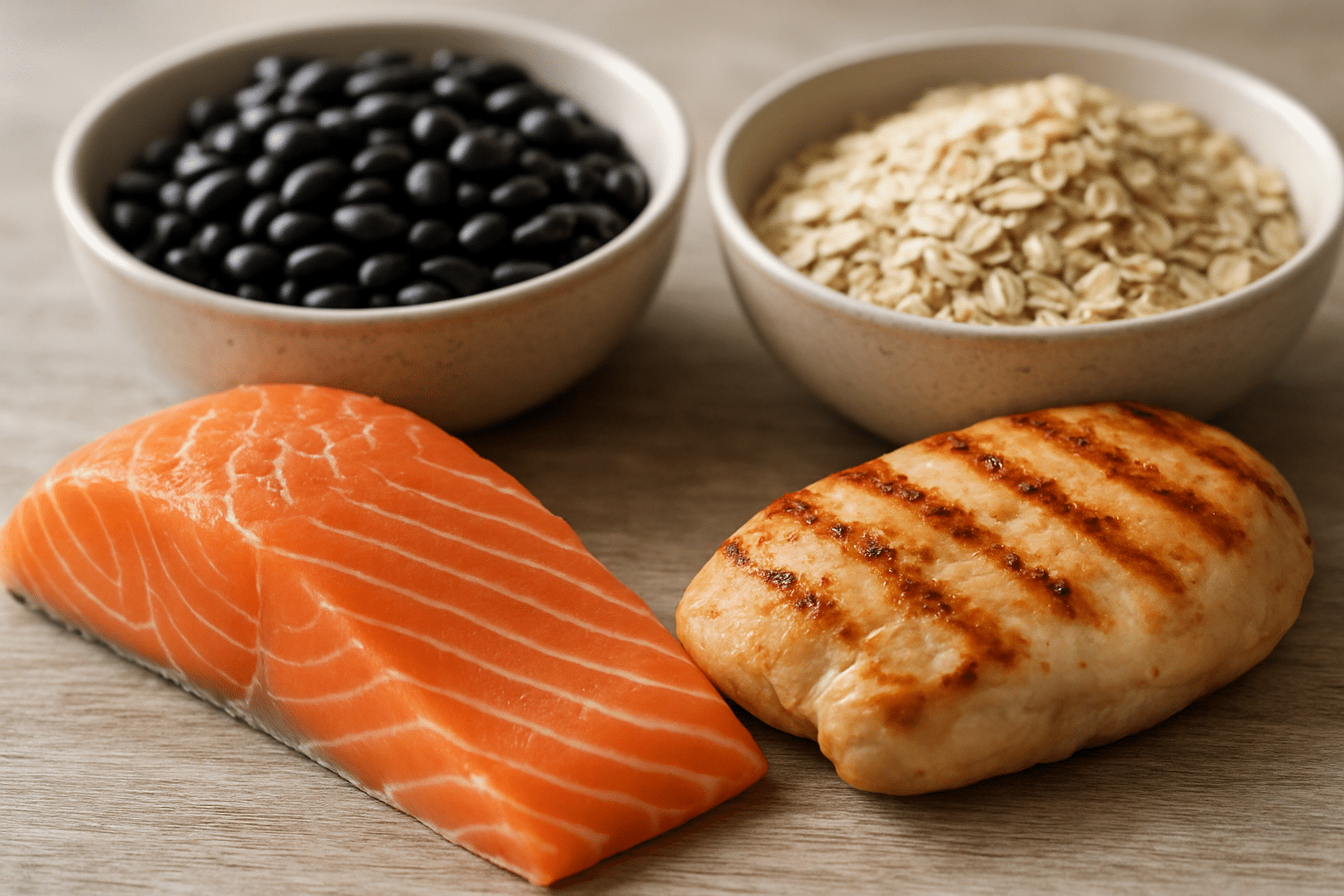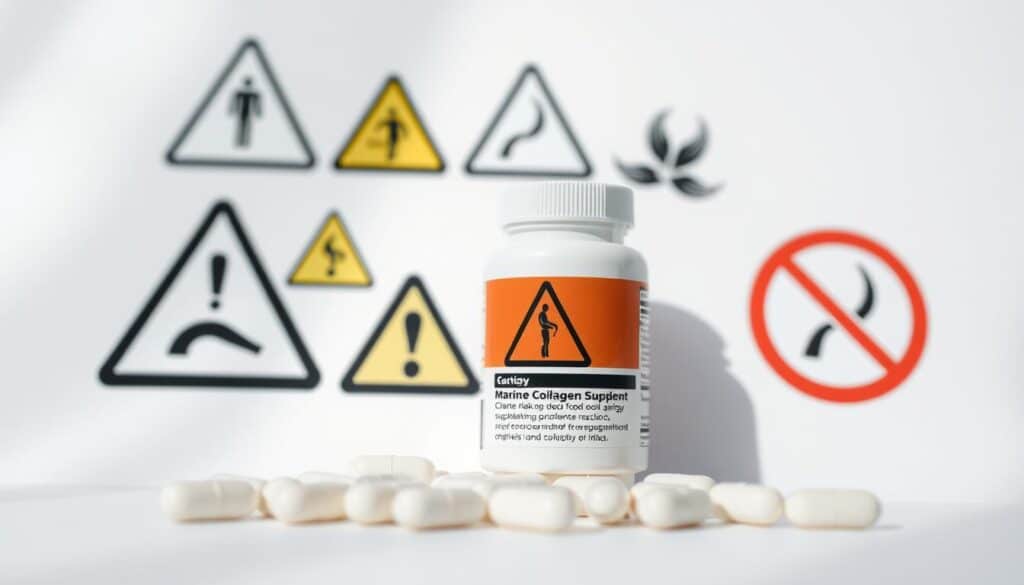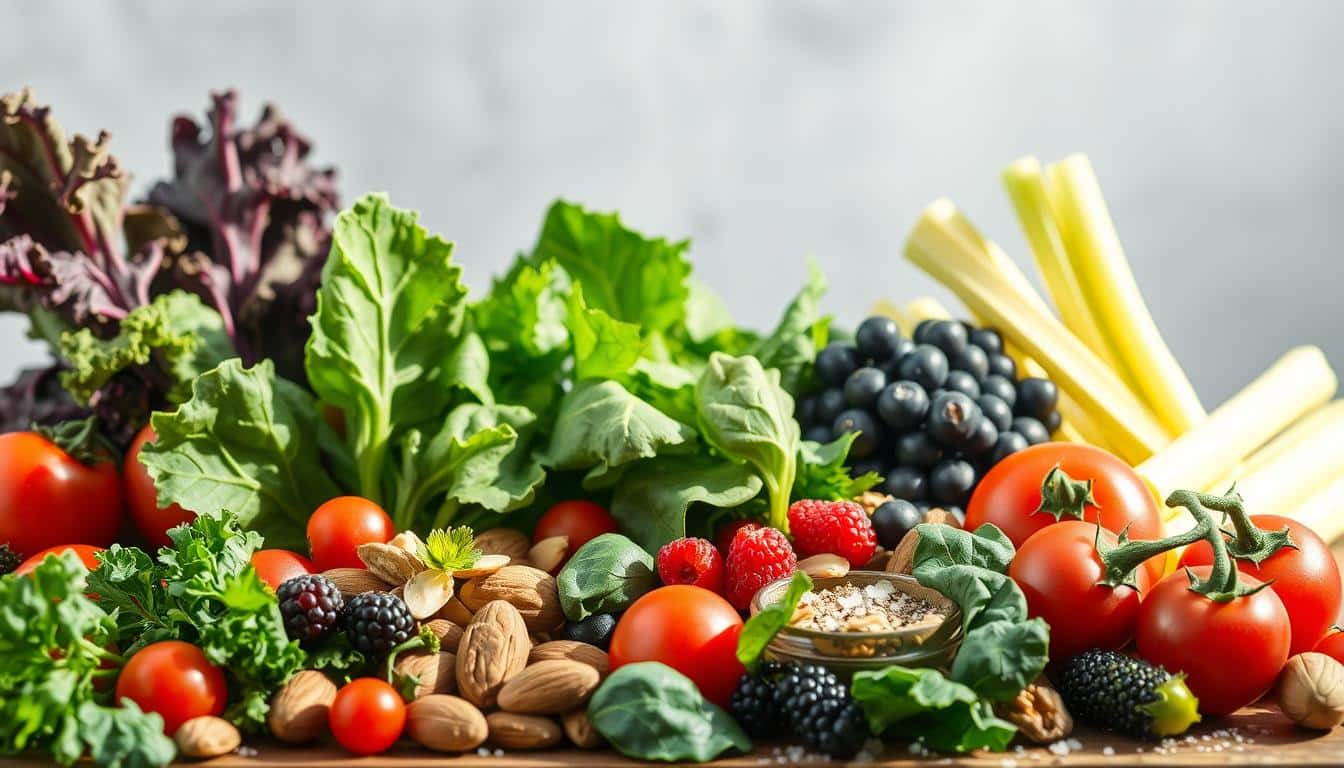Anúncios
This article explores how diet can boost skin health by providing dietary collagen and the nutrients that support its production. You will find evidence-based guidance on natural foods rich in collagen, practical collagen foods to add to meals, and clear differences between skin collagen sources from food, topical products, and supplements.
Anúncios
Eating whole-food collagen foods like bone broth, fish, and poultry, alongside vitamin C-rich produce, nuts, seeds, and legumes, supports better skin elasticity, a reduced appearance of fine lines, improved wound healing, and a healthy glow. Pairing these foods with cofactors such as vitamin C, zinc, and copper helps your body make and protect collagen.

Natural Foods Rich in Collagen
We focus on real, whole-food options rather than quick fixes. Sections ahead cover the science of collagen, top animal and plant sources, recipes and meal timing, myths versus facts, and safety notes for those with allergies or medical conditions. If you have a health condition or take medications, consult a healthcare provider before changing your diet.
Anúncios
Key Takeaways
- Natural foods rich in collagen and their precursors can support skin structure and elasticity.
- Combine collagen foods with vitamin C, zinc, and copper for better collagen synthesis.
- Prioritize whole-food sources like bone broth, fish, poultry, fruits, and legumes over isolated fixes.
- Expect gradual improvements—better texture, reduced fine lines, and enhanced healing over time.
- Read later sections for recipes, meal timing tips, and precautions if you have allergies or medical concerns.
Why Collagen Matters for Skin Health
Collagen is the main structural protein in the dermis. Types I and III form a dense network of fibers that act like a scaffold. This scaffold supports skin firmness, hydration, and resilience while working with elastin and hyaluronic acid to preserve skin elasticity.
Role of collagen in skin structure and elasticity
Within the dermis, collagen fibers link with elastin to create a balance between strength and stretch. Collagen role in skin means it keeps tissues plump and resists deformation from everyday expressions. When hyaluronic acid holds water around that collagen scaffold, skin stays supple and smooth.
How collagen production changes with age
After the mid-20s, the body reduces collagen synthesis by about 1% per year. The rate can speed up during menopause for many women. External factors like UV exposure from sunlight, smoking, poor nutrition, high sugar diets that cause glycation, and chronic stress accelerate breakdown and lower new production.
Visible signs of collagen loss
Signs of collagen loss include thinning skin, fine lines, deeper wrinkles, sagging, and a drop in skin elasticity. You may notice slower wound healing and more frequent bruising as supportive tissue weakens. Targeted nutrition, lifestyle changes, and sun protection can slow this decline and help the body repair collagen over time.
Natural foods rich in collagen
Choosing real foods can help support skin structure and repair. This short guide reviews practical choices, from animal collagen sources to plant precursors for collagen, and offers tips on when whole foods vs supplements make sense for daily needs.
Animal-based choices that supply collagen peptides
Bone broth benefits are well known among chefs and nutritionists. Slow-simmered beef or chicken bones release gelatin and collagen peptides into the broth. Those peptides break down into amino acids like glycine, proline, and hydroxyproline during digestion.
Chicken with skin and connective tissue, pork skin, and fish skin or scales are practical options for people who want direct dietary collagen. These animal collagen sources provide the building blocks your body uses for skin, joints, and connective tissue repair.
Plant foods that provide precursors and cofactors
Plants do not contain collagen, yet many supply what the body needs to make collagen. Vitamin C-rich fruits and vegetables such as oranges, strawberries, kiwifruit, and bell peppers are essential for collagen synthesis.
Legumes and soy bring amino acids like proline and glycine. Garlic, onions, and cruciferous vegetables add sulfur compounds that support cross-linking and structural integrity. Together, these plant precursors for collagen form a practical, vegetarian-friendly strategy.
Choosing whole-food sources over pills and powders
Whole foods deliver vitamins, minerals, and phytonutrients alongside collagen or its precursors. That nutrient matrix reduces the risk of contaminants sometimes found in poorly made products.
Supplements can help when dietary restrictions, intense training, or medical needs increase demand. Look for third-party testing, clear labeling of bovine versus marine sources, and hydrolyzed collagen peptides for better absorption when you select a product.
| Source | What it provides | Best use |
|---|---|---|
| Bone broth | Gelatin, collagen peptides, minerals | Sip daily, use in soups for bone broth benefits and easy protein |
| Chicken with skin | Collagen in connective tissue, amino acids | Roast or simmer to retain collagen-rich parts |
| Fish skin and scales | Marine collagen peptides | Add to stews or use as a source of marine collagen |
| Legumes & soy | Proline, glycine, plant protein | Include in salads, stews, and smoothies for plant precursors for collagen |
| Vitamin C-rich produce | Ascorbic acid, antioxidants | Pair with protein sources to boost synthesis |
| Garlic, onions, crucifers | Sulfur compounds, antioxidants | Use regularly to support collagen cross-linking |
| Collagen supplements | Hydrolyzed peptides, concentrated dose | Consider when whole foods are limited; choose third-party tested products |
Top animal sources for dietary collagen
Animal proteins supply a range of collagen-building nutrients. Below we cover practical ways to add gelatin, amino acids, and marine peptides to meals. Use these tips to turn simple stock and cuts into nourishing dishes that support skin and joint health.
Bone broth: benefits, preparation tips, and variations
Bone broth is rich in gelatin and key amino acids like glycine and proline. Minerals such as calcium, magnesium, and phosphorus leach from simmered bones into the liquid, creating a nutrient-dense base. A consistent bone broth recipe yields both flavor and functional benefits for digestion and connective tissue support.
For best extraction, use a mix of marrow and knuckle bones. Add a splash of vinegar to help draw minerals out of the bones. Simmer for 12–48 hours in a slow cooker or on the stovetop, then strain and cool. Refrigerate for up to five days or freeze portions for later use. Choose bones from grass-fed or pasture-raised animals when possible to improve overall quality.
Try variations to suit taste: classic chicken bone broth, rich beef marrow broth, or vegetable-forward broths for those avoiding animal products. Each variation adapts easily into soups, stews, and sauces while delivering gelatin and amino acids.
Collagen-rich cuts of meat and poultry
Certain cuts are naturally high in connective tissue and yield more collagen when cooked slowly. Look for oxtail, short ribs, brisket, shank, chicken thighs with skin, and turkey necks. These cuts become tender while releasing collagen into cooking liquids.
Use slow braising, stewing, or pressure cooking to break down tough fibers. Slow methods transform collagen into gelatin, enriching sauces and broths. For quick weeknight prep, a pressure cooker reduces time while preserving the same collagen-rich results.
Serve these cuts with vegetables and whole grains to make balanced meals that support repair and skin resilience. Leftovers reheat well and the residual cooking liquid is excellent as a warm, nutrient-dense sip.
Marine collagen from fish and seafood
Fish skin, scales, and bones are concentrated sources of marine collagen. Fish collagen benefits often relate to smaller peptide size, which may allow easier digestion and absorption compared with some terrestrial sources. Culinary options include fish stock, fish head soups, and shellfish shells simmered into broth.
Make a simple fish stock by simmering heads, frames, and skins for one to three hours. Combine with aromatics and strain, then use as a base for soups or risottos. Shellfish shells from shrimp or lobster make flavorful stock that adds both umami and marine collagen.
When sourcing, favor wild-caught or responsibly farmed seafood to lower contaminant risk. Exercise caution with large predatory fish because of mercury. Smaller fish like sardines and mackerel often offer a safer profile and solid fish collagen benefits.
Plant foods that support collagen production
Building strong skin with a plant-forward approach centers on three simple ideas: supply vitamin C, deliver amino acids, and shield collagen from damage. A diet rich in whole fruits, vegetables, legumes, nuts, seeds, and select algae gives plant support for collagen while keeping meals colorful and easy to prepare.
Vitamin C-rich fruits and vegetables to boost synthesis
Vitamin C foods are essential because vitamin C acts as a cofactor for prolyl and lysyl hydroxylase enzymes. These enzymes help hydroxylate proline and lysine, steps that allow collagen molecules to mature and form strong cross-links.
Top choices include citrus fruits, kiwifruit, strawberries, papaya, red and yellow bell peppers, broccoli, Brussels sprouts, and kale. Add a handful of strawberries to morning oatmeal or slice bell peppers into salads to make vitamin C intake effortless.
Protein plant sources and amino acids important for collagen
Plant protein for collagen means focusing on foods that supply glycine, proline, and lysine, or combinations that create a full amino acid profile. Legumes such as lentils, chickpeas, and black beans are reliable sources.
Soy products like tofu and tempeh, quinoa, nuts and seeds such as pumpkin seeds and almonds, plus spirulina, provide complementary amino acids. Pair grains with beans or toss seeds into salads to ensure your meals deliver the building blocks collagen needs.
Phytonutrients and antioxidants that protect collagen
Antioxidants for skin reduce oxidative stress that breaks down collagen. Flavonoids, carotenoids, and polyphenols in berries, green tea, turmeric, and dark chocolate defend connective tissue from free radicals.
Sulfur-containing vegetables such as garlic, onions, and cruciferous vegetables support sulfur-based amino acids that help maintain connective tissue. Add a cup of blueberries or a cup of steamed broccoli to daily menus to boost antioxidant intake and protect new collagen.
Vitamins, minerals, and cofactors that enhance collagen
Strong, flexible collagen depends on more than bone broth and meat. The body needs specific vitamins, minerals, and cofactors for collagen to form, stabilize, and resist breakdown. Small changes in diet deliver big returns for skin tone and wound repair.
Vitamin C: dosage and food sources
Vitamin C is essential for collagen synthesis and for converting procollagen into mature fibers. Aim for at least 75–90 mg/day (U.S. RDA: 90 mg for men, 75 mg for women). Practical intakes up to 200 mg/day from whole foods can support tissue repair during recovery or intense training. The tolerable upper intake level is 2,000 mg/day.
Top food sources include oranges, strawberries, kiwi, bell peppers, and broccoli. If you use a supplement, choose a trusted brand and avoid very high doses long term. Getting vitamin C from food adds flavonoids and fiber that aid skin health.
Zinc and copper: role in collagen cross-linking
Zinc plays a direct role in collagen synthesis and wound healing. Copper is required for lysyl oxidase, the enzyme that cross-links collagen fibers and stabilizes the matrix. Together they help tissue resist stretching and damage.
Rich zinc sources are oysters, beef, and pumpkin seeds. Copper is abundant in shellfish, liver, nuts, seeds, and whole grains. High-dose zinc supplements can cause copper deficiency, so aim for balance when using supplements. Foods that supply both trace minerals make balance easier.
Other nutrients to include for optimal skin health
Vitamin A supports skin turnover. Find it in sweet potatoes, carrots, and liver. B vitamins such as biotin and riboflavin help maintain healthy skin and nails.
Omega-3 fatty acids from salmon, mackerel, and walnuts reduce inflammation that speeds collagen breakdown. Adequate protein intake, roughly 0.8–1.2 g/kg depending on age and activity, supplies amino acids needed to build new collagen.
Hydration matters for tissue elasticity. Limit added sugars to reduce glycation, a process that stiffens proteins and harms collagen. When combined, these nutrients create a supportive environment for collagen repair and resilience.
Meals and recipes to increase collagen intake

Simple meals make it easy to add collagen-supporting nutrients to every day. Use hearty broths, bright salads, and smart snacks to keep protein, vitamin C, and healthy fats in steady supply. Below are practical recipe frameworks and quick tips for busy cooks.
Easy bone broth-based soups and stews
Chicken bone broth and vegetable soup: simmer chicken bones with onion, celery, garlic, and a handful of carrots. Add chopped kale and diced bell pepper near the end for vitamin C and color. Use low-sodium broth and finish with fresh parsley and lemon juice.
Beef bone broth pho-style: combine beef bones with star anise, cinnamon, and ginger. Serve with rice noodles, thin-sliced beef, bean sprouts, basil, and lime wedges for a bright finish.
Seafood stock chowder: make a seafood stock from shrimp shells or fish bones. Add potato, corn, leeks, and a splash of cream or coconut milk for richness. Top with chives and a squeeze of lemon.
Prep tip for busy cooks: use a pressure cooker or Instant Pot to reduce simmer time to two to three hours while keeping rich collagen extraction. Freeze portions in mason jars for easy reheating and regular use of bone broth recipes.
Salads and bowls with collagen-supporting ingredients
Quinoa grain bowl: combine cooked quinoa with roasted chicken thigh, avocado, citrus segments, pumpkin seeds, and mixed greens. Dress with olive oil and lemon for a balanced collagen-boosting meal.
Mediterranean bowl: layer sardines or canned tuna with tomatoes, roasted bell peppers, cucumbers, olives, and a lemon-oregano vinaigrette. Add whole-grain pita or farro for texture.
Tofu and edamame salad: toss cubed tofu and edamame with spinach, sliced strawberries, toasted sesame seeds, and a citrus-miso dressing. This pairing emphasizes protein and vitamin C together.
Every salad and bowl should pair protein, vitamin C, and healthy fats. That mix supports collagen synthesis while keeping meals satisfying and flavorful. These salads for collagen work as lunches or light dinners.
Snack ideas to maintain steady nutrient intake
Greek yogurt with mixed berries and walnuts makes a creamy, protein-forward snack. Citrus slices with pumpkin seeds offer quick vitamin C plus zinc-rich seeds. Chickpea hummus with red pepper strips gives fiber and plant protein.
Warm bone broth sips are a low-effort snack, great between meals to boost amino acids. Jerky from collagen-rich cuts provides portable protein for travel or busy days. For a blended option, try a smoothie with spinach, frozen berries, pea protein, and a splash of orange juice for a collagen-supporting drink.
| Meal Type | Key Ingredients | Prep Time | Why it Supports Skin |
|---|---|---|---|
| Bone broth soup (chicken) | Chicken bones, carrots, kale, bell pepper, lemon | 2–3 hours in Instant Pot | Provides gelatin and amino acids plus vitamin C from vegetables |
| Beef pho-style | Beef bones, ginger, star anise, rice noodles, lime | 2–3 hours pressure cook | Concentrated collagen precursors with vitamin C at serving |
| Quinoa grain bowl | Quinoa, roasted chicken thigh, avocado, citrus, pumpkin seeds | 20–30 minutes | Balanced protein, healthy fat, and vitamin C for synthesis |
| Mediterranean bowl | Sardines, tomatoes, bell peppers, farro, lemon | 15–25 minutes | Omega-3s, protein, and citrus to aid collagen formation |
| Tofu & edamame salad | Tofu, edamame, spinach, strawberries, sesame | 10–15 minutes | Plant protein plus vitamin C pairing enhances synthesis |
| Skin-healthy snack platter | Greek yogurt, berries, walnuts, pumpkin seeds, citrus | 5–10 minutes | Quick protein and antioxidants to protect and feed collagen |
Timing, portioning, and pairing foods for better collagen absorption
What you eat and when you eat it can shape how your body builds and maintains collagen. Simple tweaks—pairing foods, spacing protein across the day, and choosing sensible portions—help support synthesis and repair without complex rules.
Combining collagen sources with vitamin C for absorption
Vitamin C is essential for the hydroxylation steps that stabilize new collagen. To boost collagen absorption, pair collagen-rich foods with vitamin C at the same meal. For example, serve bone broth or roast chicken with a squeeze of lemon and a side of bell pepper salad.
Try fish with citrus salsa or a spinach and orange salad alongside turkey. These combos give cofactor support while adding antioxidants that protect newly formed collagen.
Meal timing strategies for skin repair and overnight rejuvenation
Spread protein and collagen-supporting nutrients across meals to keep a steady supply of amino acids for repair. Aim for balanced amounts at breakfast, lunch, and dinner rather than one large protein-heavy meal.
Some small studies suggest nighttime protein can aid overnight tissue repair. A modest evening snack with protein, like Greek yogurt or a small bowl of bone-broth-based soup, can be helpful. Follow practical nightly intake instead of strict timing rules.
Practical portion sizes for daily collagen support
Use concrete serving examples to guide choices. One cup of bone broth can provide roughly 8–12 g of gelatin-derived protein depending on concentration. A 3–4 oz portion of chicken or fish is a standard serving with quality amino acids.
Aim for 20–30 g of total protein per meal for most adults to support synthesis. Include 1–2 servings of vitamin C-rich fruits or vegetables per meal, such as 1 cup raw bell pepper or ½ cup cooked broccoli.
Older adults may need higher targets, about 1.0–1.2 g/kg/day of protein, so bump portion sizes or add an extra protein-rich snack. These portion sizes collagen tips help keep intake realistic and consistent.
- Example meal: 1 cup bone broth, 3 oz grilled salmon, spinach salad with orange segments.
- Evening snack: ¾ cup Greek yogurt with strawberries or a small cup of broth.
- Daily target: Distribute protein across meals to support steady collagen absorption.
Common myths and facts about dietary collagen and skin care
Many readers ask whether dietary changes alone will erase lines and restore firmness. This short guide sorts collagen myths from what science shows. Expect clear, practical points you can use with meals and skin routines.
Can eating collagen directly translate to better skin?
When you eat collagen, stomach enzymes break it into amino acids and small peptides. Some peptides may act as signaling molecules that tell the body to make more collagen. Clinical trials of hydrolyzed collagen supplements report modest gains in skin elasticity and reduced wrinkle depth after weeks to months of use.
Whole-food approaches, such as bone broth, lean poultry, and fish, deliver collagen-building amino acids plus vitamin C, zinc, and other cofactors. Those broader nutrient profiles support overall skin health beyond single-ingredient fixes.
Topical vs dietary collagen
Topical collagen creams usually contain large molecules that sit on the skin and work as occlusives or humectants. They help hydration but rarely penetrate the deep dermis to rebuild structural collagen.
Oral collagen supplies the raw materials for repair and can influence the skin from within. For targeted collagen stimulation, topical retinoids and vitamin C serums have stronger local evidence for boosting dermal collagen synthesis.
Evidence-based benefits and realistic expectations
Research shows some benefit for oral collagen, but results vary by study design, collagen source, dose, and participant age. Changes tend to occur gradually over months rather than overnight.
Best practice combines diet, sun protection, sleep, and stress management to support long-term skin health. Use supplements and topical treatments as part of a broader plan, not as miracle cures.
| Question | Common claim | What evidence shows |
|---|---|---|
| Does eating collagen help skin? | Eating collagen directly rebuilds skin collagen overnight | Oral collagen provides amino acids and peptides that may signal collagen production; clinical trials show modest improvements after weeks to months |
| Topical vs oral collagen | Topical collagen penetrates deeply and rebuilds dermal collagen | Topical collagen mainly hydrates the surface; oral collagen supplies building blocks; topical retinoids and vitamin C better stimulate local synthesis |
| Overall benefits | Supplements replace the need for diet and sun protection | Evidence for collagen benefits is mixed; best outcomes come from combined diet, protection, and lifestyle measures |
Precautions, allergies, and who should consult a provider

Before adding new collagen foods or supplements, check personal risks and medical needs. Some people tolerate collagen-rich diets well. Others face problems from hidden allergens, supplement additives, or medical interactions. Read labels and ask questions when in doubt.
Allergies tied to seafood, eggs, and other animal sources
Fish, shellfish, and egg allergies can make marine collagen and other animal-derived products unsafe. People with food allergies marine collagen should avoid supplements labeled as fish or shellfish-derived.
Bovine and porcine collagen may conflict with religious or dietary rules. Those concerns mean choosing plant precursors or clearly labeled allergen-free formulas. Always inspect ingredient lists for cross-contamination warnings.
Possible interactions with medications and health conditions
Collagen interactions can arise when supplements contain high levels of specific amino acids, vitamins, or minerals. People on blood thinners should be cautious when changing vitamin K–rich foods. Those with kidney disease must watch high-protein regimens.
Excess zinc can upset copper balance. Check supplement labels for potencies and additive ingredients. Ask a pharmacist to review potential drug–supplement interactions before starting a new product.
When to seek personalized nutrition or dermatology advice
If you have severe allergies, eczema, psoriasis, autoimmune disease, recent surgery, or slow-healing wounds, consider professional guidance. A registered dietitian or an MD can tailor recommendations to your needs.
To find help, contact the Academy of Nutrition and Dietetics for a registered dietitian nutritionist or the American Academy of Dermatology for dermatologist referrals. For urgent reactions, seek emergency care and consult a provider right away.
| Concern | Who is affected | Suggested action |
|---|---|---|
| Marine or shellfish allergy | People with fish/shellfish sensitivities | Avoid marine collagen, check labels, use plant-based collagen precursors |
| Religious or dietary restrictions | Those avoiding pork or beef | Choose certified sources or alternative supplements |
| Medication interactions | Patients on anticoagulants or multiple prescriptions | Review with pharmacist or prescriber before starting supplements |
| Kidney or liver disease | Individuals managing chronic organ conditions | Limit high-protein intakes; consult a nephrologist or dietitian |
| Severe skin or autoimmune conditions | People with eczema, psoriasis, or autoimmune disorders | See a dermatologist or registered dietitian for tailored plans |
If you notice unusual symptoms after trying a new product, do not wait. For any serious concern, consult a doctor collagen or a qualified clinician to review testing and safe alternatives.
Conclusion
This natural collagen foods summary highlights practical steps you can take to improve skin with diet. Focus on real foods: bone broth, connective-tissue-rich meats, fish, vitamin C–packed fruits and vegetables, legumes, nuts, and seeds. Pairing these sources with vitamin C helps the body use amino acids for collagen production, while antioxidants and minerals protect existing collagen.
Start small with a simple plan: add one cup of bone broth twice weekly, include a vitamin C-rich fruit or vegetable at each meal, spread protein across the day, and try one recipe from the collagen food guide each week. These modest habits make nutrient intake consistent and more sustainable than drastic changes.
Expect gradual improvements rather than overnight results. Protect skin from excess sun, avoid smoking, and prioritize sleep to support repair. For personalized advice or if you have allergies or medical conditions, consult a healthcare provider. Explore recipes, make small, steady changes, and enjoy the process of using food to support healthier skin.


